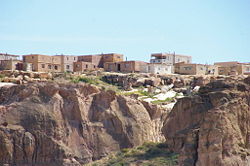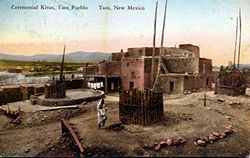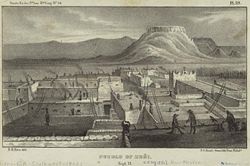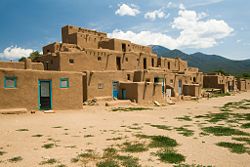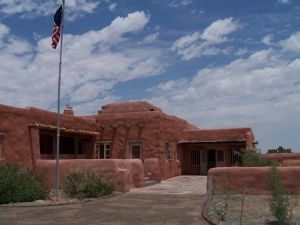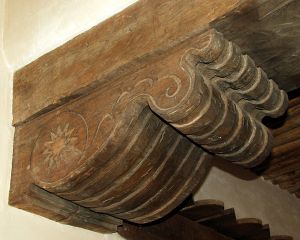Pueblo
- This article is about the communities of apartment-like structures in the Southwestern United States of America. For the people who live in these communities, see Pueblo People.
Pueblo is a term used to describe modern (and ancient) communities of Native Americans in the Southwestern United States of America. The first Spanish Explorers of the Southwest used this term to describe communities that consisted of apartment-like structures made from stone, adobe mud, and other local material. These structures were usually multi-storeyed buildings surrounding an open plaza and were occupied by hundreds to thousands of Pueblo People.
Etymology and usage
The Spanish word pueblo, evolved from the Latin word populus (people), meaning "town." The Spanish explorers discovered Native Americans living in these clusters of dwellings when they reached the Southwest in the sixteenth century:
On the central Spanish meseta the unit of settlement was and is the pueblo; that is to say, the large nucleated village surrounded by its own fields, with no outlying farms, separated from its neighbours by some considerable distance, sometimes as much as ten miles or so. The demands of agrarian routine and the need for defence, the simple desire for human society in the vast solitude of the plains, dictated that it should be so. Nowadays the pueblo might have a population running into thousands. Doubtless they were smaller in the early middle ages, but we should probably not be far wrong if we think of them as having had populations of some hundreds.[1]
In the local language of the inhabitants, the pueblo is referred to as "the village."
Historical Pueblos
Pre-Columbian towns and villages in the Southwest were located in defensive positions, for example, on high steep mesas such as Acoma. Their large, multi-family houses were called pueblos by the Spanish when they arrived in the sixteenth century. These early residents of the area are often referred to as puebloan cultures: "The Late Puebloan cultures built the large, integrated villages found by the Spaniards when they began to move into the area."[2]
In fact, both Native Americans and Spaniards shared the same architectural answers to the problems met when living in areas with low rates of rainfall and a wide variation in temperature, namely the construction of houses with clay or stone walls and flat, beam supported, earth-covered roofs.[2] The differences between the two architectures lay not in the method, but in the design:
The Pueblo Indians constructed a house incorporating their own standards of room size and proportions, squareness, wall thickness, overall height, the relationship between rooms, and the size, shape, location, and design of doors and windows. All of these differed from the standards a Spaniard would have employed in building a house. Spanish and Pueblo Indian builders in New Mexico used the same methods to roof a room or make a beam over a doorway, but these methods had to serve different cultural needs, and, therefore, differed in many details.[2]
The buildings in these pueblos were designed to provide defense. Thus, many were built atop mesas. The walls of pueblo buildings are made of limestone blocks or large adobe bricks made from clay and water. These walls were often several feet thick, as a defensive measure. Buildings were up to five stories tall, with each higher floor set back from the floor below it resulting in a step pyramid type design. Access to the rooms on lower floors was by ladders on the outside to the roof, and then down an inside ladder. In case of an attack, the outside ladders could be pulled up easily.
Contemporary Pueblos
The people of some pueblos still inhabit centuries-old adobe pueblo buildings.[3] Acoma Pueblo, also known as "Sky City," was built on top of a 367-foot (112 m) sandstone mesa in New Mexico. Settled around 1100, it is one of the oldest continuously inhabited communities in the United States.
Taos Pueblo is another ancient pueblo, approximately 1000 years old. The church at Taos Pueblo is the newest building in the pueblo having been built in 1850 to replace the original pueblo church which was destroyed by the US army in 1847.
There are 21 federally recognized Pueblos[4] that are home to Pueblo people:
|
|
|
Adobe and light construction methods resembling adobe now dominate architecture at the many pueblos of the area, in nearby towns or cities and in much of the American Southwest.[5]
Pueblo Revival Style architecture
The Pueblo Revival Style is a regional architectural style of the Southwestern United States which draws its inspiration from the Pueblos and the Spanish missions in New Mexico. The style developed at the turn of the 20th century and reached its greatest popularity in the 1920s and 1930s, though it is still commonly used for new buildings. Pueblo style architecture is most prevalent in the state of New Mexico.
Features
Pueblo style architecture seeks to imitate the appearance of traditional adobe construction, though more modern materials such as brick or concrete are often substituted. If adobe is not used, rounded corners, irregular parapets, and thick, battered walls are used to simulate it. Walls are usually stuccoed and painted in earth tones. Multistory buildings usually employ stepped massing similar to that seen at Taos Pueblo. Roofs are always flat. A common feature is the use of projecting wooden roof beams (vigas), which often serve no structural purpose.[6]
History
Although the regional architecture from which the Pueblo Style draws its inspiration is confined to New Mexico and parts of Arizona, the style first appeared in California. Boston architect A. C. Schweinfurth used it for a number of his buildings in California, beginning with a hotel in Ventura which was completed in 1894.[6]
The Pueblo Revival Style made its first appearance in New Mexico at the University of New Mexico in Albuquerque, where it was adopted by president William G. Tight for a number of projects completed during his tenure. The best-known of these was his 1908 remodeling of Hodgin Hall, though a new heating plant and the Estufa were completed earlier. Nearly all subsequent university buildings have also employed the Pueblo style, albeit in increasingly loose interpretations.[7]
The other stronghold of Pueblo style architecture is Santa Fe, where it was popularized in the 1920s and 1930s by a group of artists and architects seeking to establish a unique regional identity. In 1957 a committee led by John Gaw Meem drafted the Historical Zoning Ordinance, which mandated the use of the Pueblo Style or Territorial Style on all new buildings in central Santa Fe. This ordinance remains in effect, meaning the Pueblo Style continues to predominate.[8]
Pueblo style houses are still frequently constructed in Albuquerque, Santa Fe, and elsewhere. Updated versions of the style have also been used for newer commercial and public buildings such as the Albuquerque International Sunport terminal (1966) and the newer UNM buildings.
Notable buildings
- Estufa, University of New Mexico, Albuquerque, New Mexico (1906)
- Hodgin Hall, University of New Mexico, Albuquerque, New Mexico (1908)
- Franciscan Hotel, Albuquerque (1922, demolished)
- La Fonda Hotel, Santa Fe (1922, remodeled 1929)
- Laboratory of Anthropology, Santa Fe (1930)
- Bandelier CCC Historic District [1], Bandelier National Monument (1930's)
- Scholes Hall, University of New Mexico, Albuquerque, New Mexico (1934)
- Zimmerman Library, University of New Mexico, Albuquerque, New Mexico (1938)
- Old Airport Terminal, Albuquerque (1939)
- Painted Desert Inn, Petrified Forest National Park (1940)
Notes
- ↑ Richard A. Fletcher, Saint James's Catapult: The Life and Times of Diego Gelmírez of Santiago de Compostela, Oxford: Oxford University Press, 1984, ISBN 0198225814). on-line text, ch. 1 Retrieved June 10, 2011.
- ↑ 2.0 2.1 2.2 James E. Ivey, In the Midst of a Loneliness: The Architectural History of the Salinas Missions (University of Michigan Library, 1988).
- ↑ Daniel Gibson, Pueblos of the Rio Grande: A Visitor's Guide (Tucson, AZ: Rio Nuevo Publishers, 2001, ISBN 1887896260), 78.
- ↑ Department of the Interior, Bureau of Indian Affairs, "Indian Entities Recognized and Eligible To Receive Services From the United States Bureau of Indian Affairs; Notice" Federal Register December 5, 2003, Part III. Retrieved June 10, 2011.
- ↑ Paradis, Thomas W. (2003) Pueblo Revival Architecture, Dept. of Geography, Planning and Recreation, Northern Arizona University
- ↑ 6.0 6.1 Marcus Whiffen, American Architecture Since 1780 (Cambridge, MA: MIT Press, 1969, ISBN 0262230348), 229-233
- ↑ Van Dorn Hooker, Only in New Mexico: An Architectural History of the University of New Mexico, the First Century 1889-1989 Albuquerque, NM: University of New Mexico Press, 2000, ISBN 0826321356)
- ↑ Richard Harris, National Trust Guide: Santa Fe (New York, NY: John Wiley & Sons, Inc, 1997, ISBN 0471174432), 3-6.
ReferencesISBN links support NWE through referral fees
- Fletcher, Richard A. Saint James's Catapult: the life and times of Diego Gelmírez of Santiago de Compostela. Oxford: Oxford University Press, 1984. ISBN 0198225814
- Gibson, Daniel. Pueblos of the Rio Grande: A Visitor's Guide. Tucson, AZ: Rio Nuevo Publishers, 2001. ISBN 1887896260
- Harris, Richard (1997). "National Trust Guide: Santa Fe. New York: John Wiley & Sons, Inc. ISBN 0-471-17443-2
- Hooker, Van Dorn (2000). "Only in New Mexico: An Architectural History of the University of New Mexico, the First Century 1889-1989. Albuquerque: University of New Mexico Press. ISBN 0-8263-2135-6
- Whiffen, Marcus (1969). American Architecture Since 1780. Cambridge: MIT Press. ISBN 0-262-23034-8
External links
- The SMU-in-Taos Research Publications digital collection contains nine anthropological and archaeological monographs and edited volumes representing the past several decades of research, primarily on Pueblo Indian ruins and excavations, at the SMU-in-Taos (Fort Burgwin) campus near Taos, New Mexico, including Papers on Taos archaeology, Taos archeology, Pueblo through time: eight centuries of change in a northern Rio Grande pueblo and Excavations at Pot Creek Pueblo.
| |||||
Credits
New World Encyclopedia writers and editors rewrote and completed the Wikipedia article in accordance with New World Encyclopedia standards. This article abides by terms of the Creative Commons CC-by-sa 3.0 License (CC-by-sa), which may be used and disseminated with proper attribution. Credit is due under the terms of this license that can reference both the New World Encyclopedia contributors and the selfless volunteer contributors of the Wikimedia Foundation. To cite this article click here for a list of acceptable citing formats.The history of earlier contributions by wikipedians is accessible to researchers here:
The history of this article since it was imported to New World Encyclopedia:
Note: Some restrictions may apply to use of individual images which are separately licensed.
